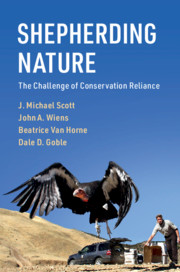Book contents
- Shepherding Nature
- Shepherding Nature
- Copyright page
- Contents
- Preface
- Acknowledgments
- 1 Extinction and the Challenge of Conservation Reliance
- 2 The Conservation Spectrum
- 3 The Genesis of Conservation Reliance and the Language of Conservation
- 4 What Are the Threats?
- 5 Emerging Threats in a Rapidly Changing World
- 6 The Role of Policy and Law
- 7 What’s in the Conservationist’s Toolbox: Species-Centered Approaches
- 8 Expanding the Conservationist’s Toolbox: Going Beyond Species
- 9 Conservation Reliance Is a Human Issue
- 10 Making Tough Decisions: Prioritizing Species for Conservation
- 11 Being a Good Shepherd
- Book part
- Essay Contributors
- References
- Index
4 - What Are the Threats?
Published online by Cambridge University Press: 28 February 2020
- Shepherding Nature
- Shepherding Nature
- Copyright page
- Contents
- Preface
- Acknowledgments
- 1 Extinction and the Challenge of Conservation Reliance
- 2 The Conservation Spectrum
- 3 The Genesis of Conservation Reliance and the Language of Conservation
- 4 What Are the Threats?
- 5 Emerging Threats in a Rapidly Changing World
- 6 The Role of Policy and Law
- 7 What’s in the Conservationist’s Toolbox: Species-Centered Approaches
- 8 Expanding the Conservationist’s Toolbox: Going Beyond Species
- 9 Conservation Reliance Is a Human Issue
- 10 Making Tough Decisions: Prioritizing Species for Conservation
- 11 Being a Good Shepherd
- Book part
- Essay Contributors
- References
- Index
Summary
Understanding threats and our ability to manage them is the first step in shepherding conservation-reliant species toward sustainability or recovery. This chapter contrasts situations in which a single threat dominates with more complex situations in which multiple threats interact. Interactions among threats raise the likelihood of conservation reliance, as this chapter illustrates in a case study of vultures. Several other case studies illustrate the effectiveness of different legal and management approaches to imperilment and the importance of identifying its root causes. Case studies, including some revolving around dams, also illustrate the complexities that attend socioeconomic drivers of imperilment and differences in the scale and manageability of threats. The chapter also describes several threats such as storms, tsunamis, or volcanic eruptions that are not manageable.
Keywords
- Type
- Chapter
- Information
- Shepherding NatureThe Challenge of Conservation Reliance, pp. 84 - 129Publisher: Cambridge University PressPrint publication year: 2020



